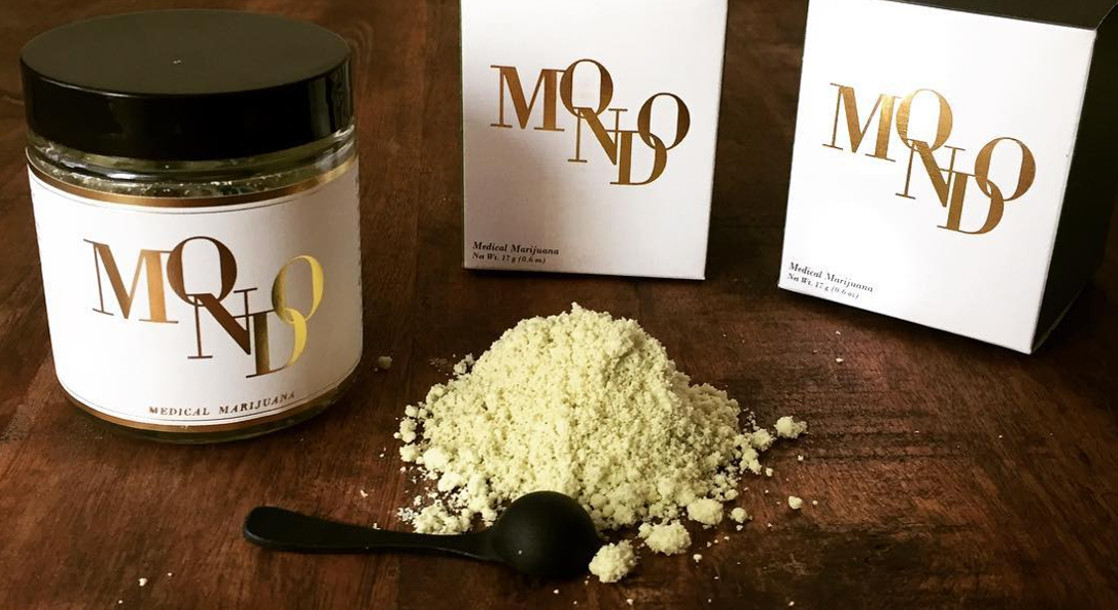Photo via Mondo Meds
Powdered cannabis edibles have already hit legal marijuana markets along the West Coast. With time, they may completely revolutionize the way we cook with cannabis – or consume weed in general.
Powdered pot is nothing new. Humans have ground cannabis flowers into fine dusts since we first discovered we could get lifted on the stuff. What’s new about powdered cannabinoids is that they’re not flowers. They’re cannabis oils specially prepared to dissolve in water, something thought impossible until recently.
So, how does it work? Although individual manufacturers offer slight variations on the technology, all versions follow the same approach. Cannabinoids, like THC or CBD, are encapsulated with a starch or other carbohydrate. When this happens, the nanoscopic cannabinoid droplet behaves like a sugar, and sugars can dissolve in water, unlike oil.

CBD-infused Instant Coconut Water, image courtesy Oleo
“When you put it in your mouth, it starts absorbing immediately through your carbohydrate uptake pathways. Your body recognizes it as a carbohydrate,” says Skyler Bissell, COO of Oleo Inc in Washington State. Oleo spent years developing a proprietary process to create encapsulated cannabinoids powders that, when mixed with water, can infuse flavored teas, coconut water, and most other edibles.
Bissell confirmed that Oleo’s powdered cannabis products can take as little as 20 minutes to begin binding to the body’s cannabinoid receptors. This contrasts with oils which, like cannabis-infused butters, begin absorbing into the bloodstream only after reaching the small intestines. “By the time a traditional product has begun to dissolve,” Bissell adds, “our product has had a significant amount of time to already do so.”

The science behind Oleo's products, image courtesy Oleo
With the much quicker reaction time offered by powdered cannabis, consumers greatly reduce their chances of taking too much, which has become an issue with edibles in the age of legalization. Conventional, oil-based edibles can take as long as two hours to take effect, which can lead to overdosing among novice or impatient edibles consumers. In addition to preventing a too-much, too-late scenario, powdered cannabinoids may resolve other issues that currently plague THC-infused food manufacturers.
Josh Held is one of the founders of Made by Science, a California-based technology company that specializes in encapsulation techniques for the cannabis industry. Made by Science has partnered with SoCal canna-company THC Design to launch an entire line of powdered cannabis products tweaked for maximum water solubility, depending on the intended uses. For instance, drink mixes are made with one formula, whereas powders for baking use another. To pull this off, their powders require a greater range of materials to encapsulate cannabinoids beyond carbohydrates, with the resulting encapsulations designed to release cannabinoids on contact with target surfaces, whether they be water or human tissues.
“If you’re trying to stir it into large batches,” Held says of his company’s powdered products, “you have a medium that allows it to create homogenous batches.” In other words, edibles made with powdered cannabinoids spread evenly throughout a food product, ensuring more reliable dosing. Oil-based infusions tend to clump or aggregate, which can lead to some batches possessing higher or lower amounts of THC than intended.

'Mix' powdered cannabis from Made by Science & THC Design, courtesty Made by Science
Held also notes that powdered cannabis never has to be cooked, if the chef chooses that route. Since the cannabinoids and terpenes in a powdered product don’t require heat for infusion or activation, these products can achieve a biochemical profile closer to that of the original cannabis strain.
Emily O’Brien — owner of Mondo Meds, another California edibles manufacturer — says consumers of her company’s powdered cannabis often choose to skip the cooking process altogether and eat the powder straight out of the package.
“It has a similar texture to cotton candy,” says O’Brien. “As soon as you put it on your tongue, it just disappears.” She notes there is a slight hint of cannabis in Mondo Meds’ powder, but “the finish is definitely cacao butter. It leaves a creamy taste in the mouth.”
The simplicity of the powder’s use, of course, doesn’t stop at direct applications to the tongue. O’Brien says powdered cannabis makes any edible preparation as easy as adding a condiment. “You can medicate your food after it’s already plated,” she explains. “After everything is on your plate, you can just sprinkle it on like salt.” No culinary skills required.

Mondo's powdered cannabis, courtesy Mondo Meds
For now, powdered cannabinoid mixes are primarily available only on U.S. west coast, but the companies interviewed here plan to expand eastward into legal markets in coming months. Yet the powdered cannabis method is catching on internationally, extending as far as the U.K., where cannabis remains illegal even for medical use.
ToKe, who requested anonymity for this story, belongs to the Hemel Hempstead Cannabis Club — an underground medical cannabis collective in England. Because commercial cannabis products from the U.S. are unavailable, marijuana patients and their caregivers there must resort to making their own.
ToKe has provided powdered cannabinoid and terpene mixes, made from scratch, to the collective’s patients for the past year. He says he got the idea from a friend who is a molecular gastronomist, a type of culinary artist that prepares dishes using cutting-edge chemistry techniques. But you don’t have to be a trained chef to make powdered weed at home, he says.
“There’s a lot of food-grade emulsifiers you can buy,” ToKe told MERRY JANE over the phone. “Ingredients that turn oil into a powder, to create a powdered chocolate. I thought maybe that would work with cannabis oil. I tried it, and it did.”
Due to the legal situation in the U.K., ToKe reports that more and more persons using marijuana for medical purposes are seeking out powdered cannabis. Because of its form and lack of odor, there’s much less risk associated with possessing or using it. Although he believes powdered weed will gain more popularity because of its versatility, he cautions others to treat powdered cannabis as a medical product with broad but not quite universal applicability.
“Because it’s a complex carbohydrate, it contains sugars — in terms of using it for cancer it’s probably not great,” warns ToKe. Some cancers may be exacerbated by high carbohydrate intake, a phenomenon dubbed the Warburg effect. “But using it for any other medical condition,” he claims, “it works well for.”
Back in the U.S., Held foresees a future where powdered weed products like those offered by Made by Science “will replace oil-based ingredients in edibles.” He “strongly believes [that] better dispersion and ingredient integrity will substantially increase shelf life. It will also allow for a more compliant product that delivers on consistent experience.” Now that the industry has spoken, it’s time for avid marijuana consumers in legal states to put powdered cannabis to the test.











